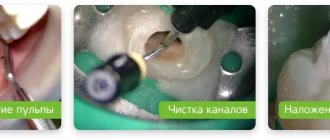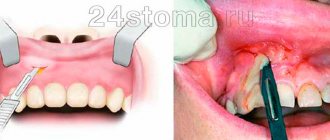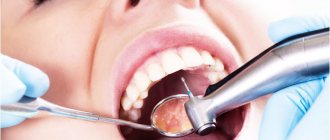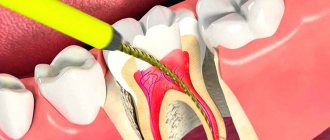Symptoms of pulpitis
- monotonous and aching pain at the initial stage of the disease,
- very strong and acute pain, which worsens closer to night. Unlike ordinary caries, the pain does not decrease, even if the irritant is removed, i.e. stop eating, drinking or brushing your teeth,
- reaction to temperature stimuli - hot and cold, and quite strong and pronounced,
- pain and acute reaction when tapping on the tooth.
Pulpitis is quite difficult to confuse with other diseases precisely because of the specific pain that accompanies the acute course of the disease. As a rule, black carious spots are present on the tooth at the same time, including they can be located under the filling (in this case it becomes dark), as well as under the crown (if the nerve has not been removed, however, in such a situation, carious inflammation will not be visible) .
Features of the treatment of trigeminal neuralgia
Toothache with neuralgia is a signal to immediately seek help from a neurologist. Inflammation of the trigeminal nerve is a serious problem that requires qualified assistance. Treatment of neuralgia must be comprehensive to achieve the best results in the fight against the disease.
In the process of treating neuralgia, it is important to correctly determine the cause and type of inflammation in order to be able to prescribe the appropriate treatment. When secondary neuralgia develops, before treating the main problem, it is necessary to eliminate the disease that was the cause.
To eliminate trigeminal neuralgia, specialists use therapeutic and surgical treatment methods. Most often, drug treatment is used in the form of drugs with an anticonvulsant effect, antihistamines, and vitamin therapy. However, if the use of medications is ineffective, it becomes necessary to act on the nerve through surgery.
Reasons for the development of the disease
- untreated caries or poor quality of filling, when an inflammatory process has developed again under the installed filling,
- preservation of the nerve under the crown - in this case (if the tightness of the prosthesis is broken, there is inflammation underneath) there is a high risk of pulp inflammation,
- tooth injury – inflammation penetrates from the outside, i.e. through cracks and chips that are located on the root or in close proximity to it,
- exposure to aggressive stimuli - temperature and chemical, for example, during previous canal treatment, naturally, with an incorrectly selected dosage of the drug.
If you have a toothache: first aid
Let us remind you once again that tooth pain is a reason to see a doctor. But for a while before visiting a doctor, you can calm the nerve with various medications and folk remedies. Let's consider these methods in more detail.
Tablets for toothache
The most effective way to calm the dental nerve is with painkillers. Often in such cases, non-steroidal anti-inflammatory drugs (NSAIDs) help, which relieve inflammation and pain. The mechanism of action of NSAIDs is associated with inhibition of cyclooxygenase, a key enzyme necessary to trigger the inflammatory process.
The most popular drugs for toothache include drugs based on nimesulide (Nimesil, Nise), ketoprofen (Ketonal, Foamax, OKI), ketorolac (Ketanov, Ketorol), meloxicam (Movalis, Movasin), ibuprofen (Nurofen) and others. In some cases, antispasmodics, for example, No-Shpa, help with toothache.
Important! Read the instructions for the medications carefully. NSAIDs and other painkillers have restrictions during pregnancy, heart disease, liver disease and kidney disease. In most cases, these drugs should not be given to children.
Folk remedies
Folk remedies are less effective in pain relief, but in the absence of drugs they will reduce pain. The most popular folk remedies for tooth pain include:
- Rinse . Rinse your mouth with decoctions of chamomile, sage or mint. A solution of soda at the rate of 1 teaspoon per glass of warm water also relieves inflammation and pain. Rinse the mouth with solutions at room temperature. After preparing the decoction, strain and cool it.
- Compresses . A cotton swab dipped in strong mint tea or a solution of water and essential oils is applied to the diseased tooth. Calendula or clove oils are often used for such purposes, as they contain anti-inflammatory and antiseptic substances.
Important! Compresses and rinses should not be hot! In some cases, high temperature will only worsen a person’s condition. If the nerve hurts after tooth extraction, then intensive rinsing is not recommended, as this can damage the film formed on the wound. Simply put the solution in your mouth and hold it for 1-2 minutes.
Complications of pulpitis
If you do not consult a dentist in a timely manner, pulpitis can develop into a more serious disease - periodontitis, cyst or granuloma, periostitis. That is, the inflammation will go deeper and go beyond the tooth root. Such complications can lead to tooth extraction, after which neighboring teeth will begin to shift, leading to malocclusion. Since the disease causes some discomfort while chewing food, the patient may face serious gastrointestinal problems.
What to do next
On the Internet you can find ways to kill the nerve of a tooth at home. To do this, it is recommended to use medical alcohol, iodine, zinc and even gunpowder. However, doctors at the Center for Israeli Dentistry categorically do not recommend resorting to such methods at home. Self-killing the nerve in some cases leads to the following complications:
- Allergic reactions to the drug. In severe cases, the allergy causes respiratory arrest.
- Damage to nearby tissues.
- Burns to mucous membranes when using aggressive agents such as concentrated alcohol or iodine.
- Taste disorder.
- Tooth infection. At home, there is a high risk of infection.
Taking into account the above circumstances, doctors at the Center for Israeli Dentistry strongly recommend that you consult a dentist if you have a toothache. Pain relief is acceptable while waiting for a visit to the doctor. It is important to eliminate the root cause of nerve irritation in the tooth (caries, pulpitis, periodontitis and others). Otherwise, a person risks losing a tooth.
Treatment methods
Treatment of pulpitis is carried out in a complex: as a rule, the nerve is removed (only in rare cases, when there is slight inflammation, it can be treated with medication and thereby kept alive for some time). After this, the canals are filled and the coronal part is restored if it is destroyed. Diagnosis and treatment monitoring are necessarily carried out using an x-ray - a targeted image of one tooth.
Dental canal treatment The dental canals are cleaned using special instruments and medications. The treatment takes 2 visits - during the first, the nerve is removed and the cavity is thoroughly cleaned. In the second, the quality of the treatment is assessed, the temporary filling is removed and a permanent one is placed.
Price:
from 4,500 rubles more details about the solution
Installation of a core tab After cleaning the dental canals, if the crown is almost completely destroyed, i.e. under the root, it is necessary to restore the tooth. An inexpensive option is to install a pin, but a more rational option is to make a stump tab that completely replicates the structure of the root system. This way the load is distributed more evenly, so the tooth will last longer. Next, you can install a crown or line the top of the inlay with a composite material.
Price:
from 5,000 rubles more details about the solution
Installing a crown Installing a crown after treatment of pulpitis may be necessary if the apex of the tooth is destroyed by more than half. For the lateral teeth, the best option would be to use metal-ceramics, for the front teeth - pure ceramics. In both cases, a crown made of zirconium dioxide is suitable, since it is characterized by increased strength and at the same time has a snow-white tint. A single prosthesis can be attached to the tooth itself (if there is something left of it), or to a pin or core tab.
Price:
from 11,000 rubles more about the solution
Medicines
Ledocaine, Ketanov, Indomethacin - first aid against pain from an inflamed tooth nerve.
You can name several of the most popular medications that are used as an anesthetic for inflammation of the dental nerve:
- Ledocaine is a very well-known local anesthetic used in various fields of medicine. To anesthetize the inflamed nerve, apply the drug (gel) to a cotton swab and apply to the affected area for fifteen minutes. If you bought the drug in the form of a spray, then spray about 20 mg on the aching tooth, repeat the procedure every hour and a half, the maximum dose per day is 20 procedures. Before starting treatment with Ledocaine, read the instructions, especially the “Contraindications” section.
- Ketanov , usually widely used in tablet form. Do not exceed the daily dose of 5 pcs. and do not take the drug for more than one week. The greatest effect is when taken before meals. Much superior to the usual Analgin and Indomethacin. The action lasts up to eight hours. There are a number of contraindications.
- Indomethacin is a good pain reliever, taken three times a day; if the effect is not sufficiently pronounced, the dose can be increased to 50 mg. It is better to use after meals and wash down with milk. With prolonged use, exacerbations of chronic diseases are possible. It is advisable to read the instructions carefully before use.
All these drugs will help relieve attacks of severe pain, but do not forget that only a visit to the dental office can relieve you of the disease itself and help avoid possible complications.
Moscow metro station Zvezdnaya, Danube Avenue, 23
How dangerous is the condition?
With severe exposure of the dental neck, a wedge-shaped defect develops. Then the units located in the atrophied zone take on a characteristic V-shape. Because of this, the appearance of the smile deteriorates. But the problem lies not only in the deterioration of aesthetics. As the pathology progresses, the likelihood of:
- Crown fracture. It becomes excessively long. Its size is naturally disproportionate. With severe chewing load, a crack may appear or a fracture may occur.
- Deformations and curvatures of the dentition. It is not always possible to restore its original appearance later. If this can be done, it will only be with the help of long-term orthodontic and orthopedic therapy.
- The appearance of cervical caries. This is always a very painful condition. Even a small spot leads to discomfort. To prevent the patient from experiencing pain during treatment, the doctor has to inject an anesthetic.
- Loosening and tooth loss. This is perhaps the most dangerous complication. This situation can only be corrected with the help of prosthetics. It is always expensive and difficult. In addition, if there is a choice between preserving a natural tooth and installing an artificial unit, preference should always be given to the former.
Dentists know of many cases where the tooth root was severely exposed, and then a bacterial infection soon followed. As a result, a fistula is formed, from which pus is constantly released. This condition is very dangerous. If the purulent process is not stopped in a timely manner, phlegmon, sepsis and other conditions that pose a threat to health and life may develop.
Content:
- Why do the roots of teeth become exposed?
- How to understand that the dental neck is exposed
- How dangerous is the condition?
- What to do if the necks of your teeth are exposed
- Gumplasty
If the tooth is healthy, the root and neck are tightly covered with gum.
Then the smile looks aesthetically pleasing, and the person is not bothered by any discomfort. But under the influence of a number of unfavorable factors, recession of the gum tissue can occur. If they drop, the neck of the tooth is exposed. As a result, the condition of the dentogingival apparatus worsens. The unit gradually becomes mobile. If appropriate measures are not taken, it will fall out. Dentists treat exposed teeth. A person cannot fix the problem on his own. Therefore, if this condition affects you, be sure to make an appointment with your doctor . Do not try to restore the primary volume of the gums using folk recipes. This will not lead to anything good. In this case, you will miss time, which means the course of the disease will worsen.
Prevention
If for some reason you had to depulpate a tooth, you should not think that now it will never bother you again - without proper preventive measures, the likelihood of pain is very high. To avoid complications, follow simple rules:
- Do not eat or drink for 2 hours after surgery - this will reduce the risk of infection under the filling. Smoking and drinking alcohol are not recommended for at least 24 hours after treatment.
- Take anti-inflammatory pain medications as recommended by your dentist.
- At first, try to reduce the chewing load on the pulpless tooth.
- Regular hygiene. Immediately after treatment, buy a toothpaste to reduce tooth sensitivity. In the future, brush your teeth 2 times a day, do not neglect dental floss and mouth rinses.
- Professional hygiene. Visit your dentist at least once every six months. Make an appointment for a professional plaque and tartar cleaning once a year. To protect your teeth from adverse external influences, go through the procedure of fissure sealing, and to strengthen the enamel - remineralization or fluoridation.
And remember - everything in our body is interconnected. Don’t wait for pain – at the first signs of discomfort after dental treatment, contact your doctor immediately.
Author: Elena Kopylova Dentist-therapist, endodontist, pediatric dentist. Work experience more than 7 years. The information is for reference only. Before treatment, consultation with a doctor is necessary.
Why do the roots of teeth become exposed?
There are various reasons why tooth roots become exposed. Among them:
- Poor oral hygiene. A person brushes his teeth poorly and irregularly, uses too hard a brush and poor-quality toothpaste.
- Oral diseases. The most dangerous provocateurs: periodontitis, periodontal disease, progressive cervical caries, atrophic gingivitis. With all these pathologies, soft tissues begin to atrophy and sag. Their volume decreases. Then the surface of the dental crown begins to look unusually long. This indicates that the cervix has opened slightly.
- Bite disorders. Some types of occlusion place very strong pressure on the gums. Because of this, you can observe exposed necks of the teeth. To eliminate the problem, it is necessary to carry out competent orthodontic treatment using mouth guards, braces or other leveling systems.
- Age-related changes. Often the disorder occurs in people over 55-60 years of age. It is associated with natural wear and tear of teeth and deterioration of their condition, a slowdown in metabolic processes and poor supply of oral tissues with the nutrients they need.
- Having a piercing in the mouth. A metal earring scratches the gums, puts pressure on them, which is why they slowly “sag.”
- Thyroid diseases, diabetes mellitus, severe autoimmune pathologies. Often, because of them, the local blood supply is disrupted, which leads to exposure of the roots of the teeth.
Hormonal disorders, bruxism, anatomical features of the location of the frenulum - all this can also provoke a problem. If you are unsure why your gums are receding, consult your dentist. He will quickly determine the cause of the violation.
Types of nerve removal
- Amputation . The pulp is not completely removed, but only its coronal part; the root pulp remains. Amputation has limited indications and is used in children when the roots of the teeth have not yet formed. In adults, it is used only when there is confidence that the neurovascular bundle is not completely affected.
- Extirpation . This method involves complete removal of the infected tooth pulp, cleaning of the root canals, followed by filling them.
Gumplasty
In advanced cases, conservative therapy does not always help. Then doctors have to perform a surgical operation aimed at:
- restoration of a healthy and beautiful gum line;
- elimination of symptoms caused by tissue atrophy;
- preventing the unit from loosening and falling out.
Gingivoplasty is a flap operation. With its help, it is possible to build up missing tissues. The operation is performed in different ways. The most popular is to take a flap of material from the palate and transfer it to the operated area.
But, if the defect is single (that is, it relates to only one tooth), such serious intervention can be avoided. The dental surgeon simply makes two horizontal and two vertical incisions and displaces the resulting flap by transferring it. After regeneration, the operated area begins to look natural and neat.
Remember: folk remedies are not able to restore atrophied gums. Do not delay treatment at the dental clinic. This is the only way to keep your teeth intact.
What to do if a pulpless tooth hurts?
First, a diagnosis is made and the causes of pain are found out. To do this, the dentist conducts an examination and takes a control x-ray. If the pain appears due to the re-development of infection, an allergy to the filling material, or due to errors in the primary treatment, retreatment is performed: the root canals are opened, re-processed and filled. If the pain is associated with caries or pulpitis in an adjacent tooth, treat it. In case of injury to the trigeminal nerve, treatment should be comprehensive, with the participation of a neurologist.
You have questions?
We will call you back within 30 seconds
+7
How to understand that the dental neck is exposed
The sooner a person notices a pathological condition, the better. In the early stages, it is much easier to correct it. Among the main symptoms:
- Lengthening the surface of the crown of the tooth. The unit begins to look very long, which is most often unnatural.
- Increase in interdental spaces. The teeth are designed in such a way that their width gradually decreases towards the gums. When the gums recede, this property becomes clearly visible. Subjectively, a person may notice that food debris has begun to accumulate between his teeth. He has to floss more often.
- Increased tooth sensitivity. Units begin to react very sharply to temperature changes, sweet, salty, sour and spicy foods.
- Gums often bleed. With atrophy of soft tissues, their condition worsens, the walls become thinner. Any inaccurate movement during hygiene procedures or chewing solid foods causes damage to them, which is manifested by bleeding.
- The appearance of the gums changes. It brightens or turns blue, sags in comparison with healthy surrounding tissues. It often looks swollen and inflamed. May hurt when pressed.
- There is an unpleasant odor from the mouth. When gums atrophy, deep gum pockets often form. They are the optimal place for the accumulation of small food debris and the proliferation of pathogenic microorganisms. It is impossible to clean them with a regular toothbrush. Therefore, no matter how much a person brushes his teeth, he cannot get rid of the fetid odor.
How to kill the pulp in dentistry
As for how to kill a nerve in dentistry, specialists for this purpose use two methods of depulpation - vital and devital. The first option involves amputation of the inflamed vascular bundle in one visit, under anesthesia. With the devitalizing method, the removal is carried out in two steps: at the first appointment, the doctor puts a devitalizing paste into the tooth and places a temporary filling on top, and at the second, he amputates the already dead pulp.
Quite aggressive arsenic compounds are used for killing. But today they are gradually being replaced by less toxic formaldehyde pastes. Below we will take a closer look at exactly what medications are used to kill the nerve.
Devitalizing pastes with arsenic: “Devit-Ars” and “Kaustinerv Rapid”
The basis of the drug "Devit-Ars" is arsenic anhydride. It leads to the gradual death of soft tissues and fairly rapid death of the pulp. To make this process painless for the patient, the composition also contains lidocaine.
The photo shows arsenic paste
It should be noted that the process of necrosis of living tissue requires strict control by a doctor, otherwise the consequences for the body can be very serious. It is very important to provide reliable protection against infection during this time. For this purpose, antiseptics are also added to the Devit-Ars paste - eugenol, chlorophenol and metacresol. As a rule, killing with this drug occurs literally within 24 hours1. In rare cases, the process takes a little longer, but usually no more than 2 days.
"Caustinerv Rapid" is another popular devitalizing drug in dentistry based on the same active substance. The composition also contains lidocaine, phenol, hydrochloric ephedrine and menthol. The devitalization process takes on average 2-3 days.
Arsenic-free pastes - formaldehyde
One of the most popular drugs in this category is Devit. It is based on paraformaldehyde, the action of which is aimed simultaneously at killing the pulp and antiseptic treatment of tissues. Lidocaine acts as an anesthetic component, and creosote is responsible for the antimicrobial properties.
Paste without the presence of arsenic can be used
To perform its immediate task, this formaldehyde paste requires much more time - up to 10 days. On the other hand, this is a much more gentle and safe method that poses virtually no threat to the body. Another important advantage of this type of devitalizing agents is the deep sterilization of the pulp chamber, which often makes it possible to preserve tissue at least partially.
Important! After arsenic paste, the doctor must carry out a very thorough treatment of the canals and make sure that there are no traces of a toxic substance there. When using formaldehyde compounds, this step can be skipped.
After 2 to 10 days, depending on the type of composition used, the patient needs to visit the doctor again to complete the treatment. He will remove the temporary filling, remove dead tissue, treat the canals and seal them. A permanent filling will be placed on top and sent for a control x-ray.











